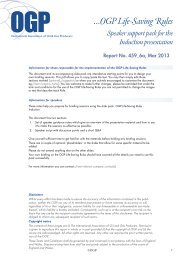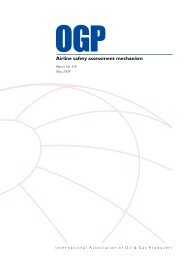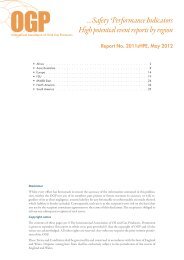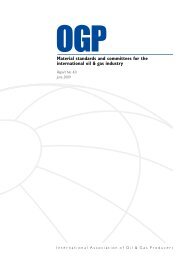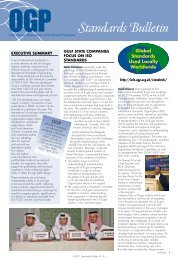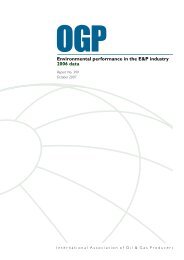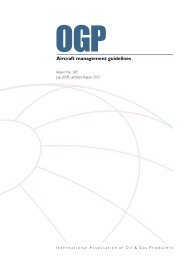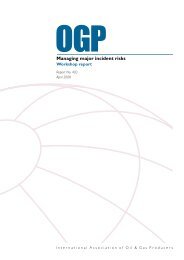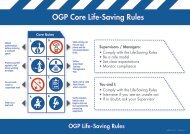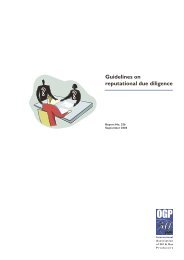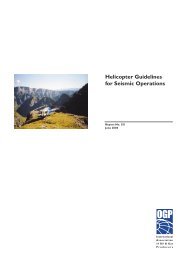Helicopter guidelines for land seismic & helirig operations - OGP
Helicopter guidelines for land seismic & helirig operations - OGP
Helicopter guidelines for land seismic & helirig operations - OGP
Create successful ePaper yourself
Turn your PDF publications into a flip-book with our unique Google optimized e-Paper software.
International Association of Oil & Gas Producers<br />
same procedures and precautions (including test sampling) as used <strong>for</strong> refueling<br />
the aircraft.<br />
4. It is recommended that, after filling, frangible “witness” seals be applied on<br />
transport tanks, to allow verification that contents have not been tampered<br />
with.<br />
5. Fuel dispensed into small bladders or re-used drums should be used within one<br />
month.<br />
D.5.3 Forward staged fuel should be stored with the same precautions as applicable to the<br />
bulk storage depot. Requirement <strong>for</strong> secondary containment may be waived <strong>for</strong> short<br />
term storage (subject to local government regulations!).<br />
D.6 Fuel provision, quality control and contamination checks<br />
D.6.1 When fuel is taken from a supplier / refinery or delivered to the fuel storage, the<br />
following must be per<strong>for</strong>med be<strong>for</strong>e this fuel is accepted and transferred to the<br />
storage:<br />
1. The fuel must be documented and this documentation must be checked to<br />
ensure the fuel received:<br />
a. Is of the correct grade and type.<br />
b. Will not reach its expiry date (one year from manufacturing) be<strong>for</strong>e use.<br />
2. If delivered by tanker, the tank must be allowed to settle <strong>for</strong> 1 hour <strong>for</strong> each 1<br />
foot of fuel depth.<br />
3. After settling, enough fuel must be pumped out of the tank and disposed of in<br />
reject storage to ensure the transfer pump and piping is filled with fresh fuel.<br />
4. A 2 liter sample must be taken into a clean glass recipient with screw top,<br />
marked with date and origin and:<br />
a. Visually inspected <strong>for</strong> color, clarity and contamination.<br />
b. Tested <strong>for</strong> water in suspension with approved water testing paste or capsules.<br />
c. Stored with the documentation of the fuel batch delivered, until this batch<br />
has been consumed.<br />
5. After filling, the storage tanks must be allowed to settle 1 hour <strong>for</strong> each 1 foot<br />
of fuel depth be<strong>for</strong>e any fuel is delivered to the helicopter.<br />
D.6.2 All required fuel samples as noted in the paragraphs below should be taken into a<br />
clean glass recipient with screw top, marked with date and origin and:<br />
1. Visually inspected <strong>for</strong> color, clarity and contamination.<br />
2. Tested <strong>for</strong> water in suspension with approved water testing capsules or kits.<br />
Water testing paste is not effective at detecting water in suspension.<br />
3. Retained until flights are completed <strong>for</strong> that day.<br />
D.6.3 Prior to the first flight of each day, the helicopter fuel tank sumps must be drained<br />
and sampled into one container (½ liter minimum sample size, unless specified<br />
differently by the airframe or water detection device manufacturer).<br />
D.6.4 Prior to the first refueling of each day, samples must be taken from the fuel delivery<br />
system:<br />
1. Each fuel tank sump (2.0 liters).<br />
2. Each fuel filter and monitor (2.0 liters).<br />
3. Each fuel nozzle, prior to first refueling of the day (2.0 liters).<br />
56<br />
© <strong>OGP</strong>



